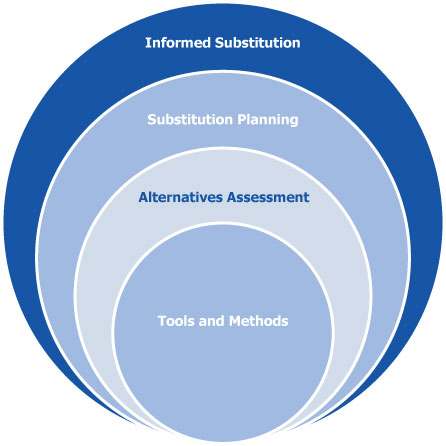Transitioning to Safer Chemicals:
A Toolkit for Employers and Workers
Basics of Informed Substitution & Alternatives Assessment

Considering safer alternatives to hazardous chemicals is not a new approach. Thinking about safer alternatives allows employers, workers, and decision-makers to identify solutions, rather than continuing to evaluate and quantify the problem. This approach can reduce costs and keep businesses competitive. On the other hand, continuing to assess a problem has no economic benefit.
Several terms and phrases are commonly used to describe this type of solutions-oriented approach to chemical management.
Informed substitution, replacing hazardous substances with safer alternatives, is the goal of a solutions-oriented approach to chemical management. It involves identifying alternatives and evaluating their health and safety hazards, potential trade-offs, and technical and economic feasibility. A safer alternative is an option that is less hazardous for workers than the existing means of meeting that need. Sometimes, this means choosing the option of not continuing an activity altogether; this also may include using chemical substitutes or product or process redesigns that completely eliminate the need for specific hazardous chemicals. Informed substitution is the goal of the seven step process presented by OSHA in this toolkit.
Substitution planning is a process to systematically set goals and priorities to reduce hazards, develop a chemical use inventory, evaluate alternatives, identify preferred alternatives, and implement alternatives. Taken together, steps 1-7 outline a substitution planning process.
An alternatives assessment is a process for identifying, comparing, and selecting safer alternatives for hazardous chemicals on the basis of their hazards, performance, and economic viability. An alternatives assessment is a key component of a substitution planning process and is used in the evaluation and comparison of alternatives.
A number of tools and methods have been developed to evaluate hazards, performance, and economic viability as part of an alternatives assessment. For example, comparative chemical hazard assessment tools provide a method to compare chemical alternatives on the basis of their chemical hazards. Steps 3-5 of the toolkit - identifying, assessing, comparing, and selecting the alternatives - include tools employers and workers can use to perform an alternatives assessment.
Further Resources
Background
Deutsche Gesellschaft für Internationale Zusammenarbeit (GIZ). Practical Chemical Management Toolkit. This toolkit provides a step-by-step process for identifying and assessing chemical hazards, managing the risks associated with the use of chemicals, and planning and preparing for any emergencies involving chemicals.
Interstate Chemicals Clearinghouse (IC2). IC2 Safer Alternatives Assessments. This website outlines a protocol for conducting safer alternatives assessments and provides a set of resources to draw from when performing an alternatives assessment.
Ontario Toxics Reduction Program. Reference Tool for Assessing Safer Chemical Alternatives. This reference tool provides support and guidance for government, industry, and other stakeholders to identify and consider safer alternatives.
Organization for Economic Co-operation and Development. Current Landscape of Alternatives Assessment Practice: A Meta-Review. This document summarizes the literature on substitution of chemicals of concern, with a focus on the current landscape of substitution practice in OECD member countries.
Frameworks
BizNGO. BizNGO Chemical Alternatives Assessment Protocol. *(PDF) This resource is a decision framework for substituting chemicals of concern to human health or the environment with safer alternatives.
BizNGO. The Guide to Safer Chemicals. This resource is a hands-on guide for downstream users of chemicals that charts pathways to safer chemicals in products and supply chains.
Chemical Commons. Principles for Alternatives Assessment. This framework includes six principles for alternatives assessment that guide a process for well-informed decision making that supports successful phase-out of hazardous products, phase-in of safer substitutes, and elimination of hazardous chemicals where possible.
European Commission. Minimizing Chemical Risk to Workers' Health and Safety Through Substitution. This report presents a systematic, yet flexible, risk-based process for chemical substitution in the workplace.
German Federal Environment Agency (Umweltbundesamt). Guide on Sustainable Chemicals. This guide assists in the selection of sustainable chemicals by providing criteria to distinguish between sustainable and non-sustainable substances.
German Federal Institute for Occupational Safety and Health (BAuA). Technical Rules for Hazardous Substances-Substitution (TRGS 600). This guidance provides a framework for identifying and evaluating substitutes and establishes criteria for assessing and comparing the health risks, physicochemical risk, and technical suitability of identified alternatives.
Interstate Chemicals Clearinghouse (IC2). Guidance for Alternatives Assessment and Risk Reduction. This document provides background information on what is found in and how to conduct an alternatives assessment.
Lowell Center for Sustainable Production. Alternatives Assessment Framework. This resource provides a framework for the quick assessment of safer and more socially just alternatives to chemicals, materials, and products of concern.
National Institute for Occupational Safety and Health. Prevention through Design (PtD). This website describes the concept of Prevention through Design, a framework for addressing occupational safety and health needs in the design process to prevent or minimize the work-related hazards and risks associated with the construction, manufacture, use, maintenance, and disposal of facilities, materials, and equipment.
National Research Council. A Framework to Guide Selection of Chemical Alternatives. This report presents a decision framework for assessing potentially safer substitute chemicals and demonstrates the use of the framework with two case studies.
U.S. EPA Design for the Environment Program. Alternatives Assessments. This website describes the key steps to conducting an alternatives assessment.
U.S. EPA. Greening Your Purchase of Cleaning Products: A Guide for Federal Purchasers. This website highlights guiding principles that provide a framework purchasers can use to make environmentally preferable purchases.
Methodologies
Massachusetts Toxics Use Reduction Institute. Five Chemical Alternatives Assessment Study. This study presents a methodology for assessing alternatives to chemical of concern based on performance, technical, financial, environmental, and human health parameters.
U.S. EPA Design for the Environment Program. Cleaner Technologies Substitutes Assessments. This publication presents the methods and resources needed to conduct a Cleaner Technologies Substitutes Assessment (CTSA), a methodology for evaluating the comparative risk, performance, cost, and resource conservation of alternatives to chemicals currently used by specific industry sectors.

